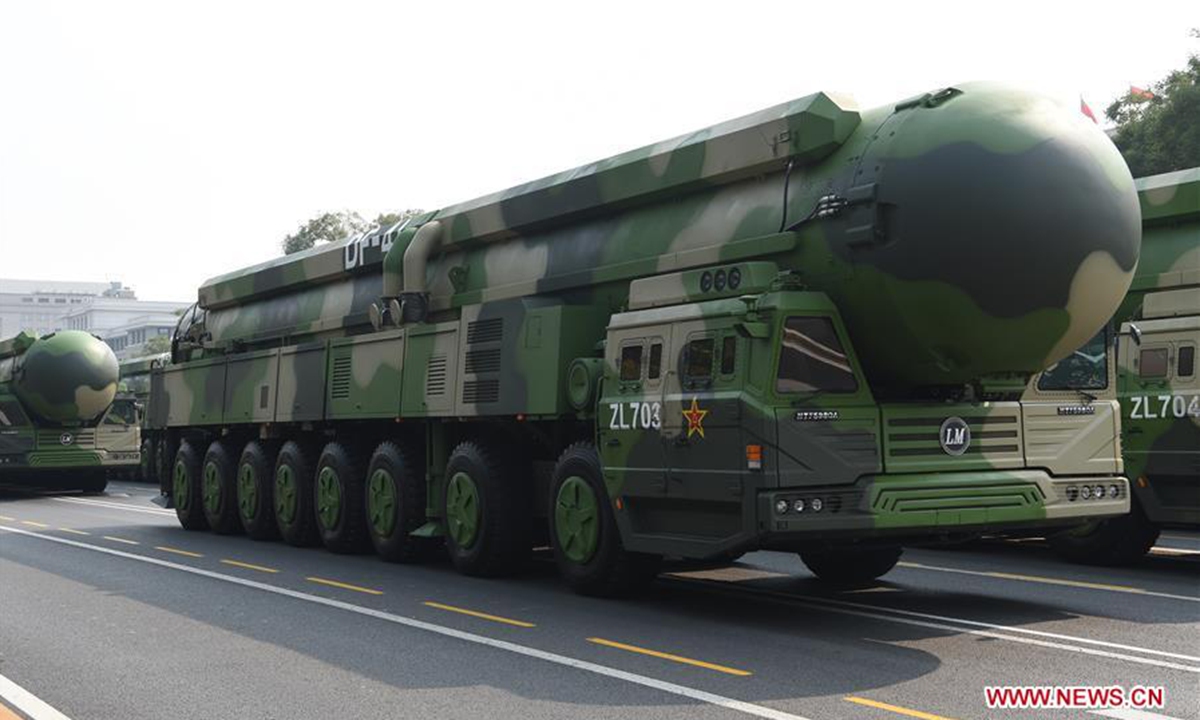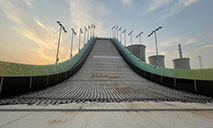New Pentagon report hypes 'Chinese nuclear threat' to serve US hegemonic goals

The formation of Dongfeng-41 nuclear missiles takes part in a military parade celebrating the 70th anniversary of the founding of the People's Republic of China (PRC) in Beijing, capital of China, Oct. 1, 2019. (Xinhua/Xia Yifang)
The US Defense Department on Wednesday released its annual report on China's military development, which again hyped the "China threat theory," and discussed China's nuclear arsenal, claiming that the Chinese People's Liberation Army (PLA) is expanding its nuclear force much faster than the US had predicted, and that it may have 1,000 nuclear warheads by the end of the decade and surpass US global influence by the middle of the 21st century.
Serving the US' own hegemonic goals, the Pentagon's speculative report aims to contain China's rightful national defense development at a time when the US is showing huge strategic malice against China by dragging it to unfair arms talks, and creates excuses to further strengthen its nuclear capability, Chinese experts said on Thursday.
Unlike the US, China will not use, or threaten to use, nuclear weapons on anyone as long as it is not attacked by a nuclear weapon first, experts said.
Titled "Military and Security Developments Involving the People's Republic of China 2021," the annual Pentagon report to the US Congress claims that the number of Chinese nuclear warheads could rise to 700 within six years, and may top 1,000 by 2030, AP reported on Wednesday.
China may already have established what is known as a nuclear triad — the combination of land-, sea-, and air-based missiles — by adding an air-launched ballistic missile (ALBM), AP cited the report as saying.
The report also asserted that China has begun constructing at least three new missile fields that "cumulatively contain hundreds" of underground silos from which intercontinental ballistic missiles (ICBM) could be launched, AP reported.
In response to the Pentagon report, Wang Wenbin, a spokesperson of China's Ministry of Foreign Affairs, said at a regular press conference on Thursday that the report disregards the facts and is prejudiced.
The US is the biggest nuclear threat in the world, as it owns 5,550 nuclear warheads as of early 2021, Wang said, citing data from international think tanks.
While the US possesses the world's largest, most advanced nuclear arsenal, it is still investing trillions of dollars to upgrade its "nuclear triad," developing low-yield nuclear weapons and lowering the threshold of using nukes, Wang said.
The US left arms control legal instruments like the Anti-Ballistic Missile Treaty and the Intermediate-Range Nuclear Forces Treaty, continued to deploy antiballistic missile systems around the world, resumed land-based intermediate-range missile development and tests, and sought to deploy them in Europe and the Asia-Pacific, Wang said, noting that the US is also creating a small clique with strong Cold War undertones through the AUKUS nuclear submarine cooperation.
These moves seriously harm global strategic stability, and damage international peace and security, Wang said, urging the US to shoulder its special and primary responsibility in nuclear disarmament by further cutting its nuclear arsenal in a verifiable, irreversible and legally binding way to safeguard global strategic balance and stability, Wang said.
Song Zhongping, a Chinese military expert and TV commentator, told the Global Times on Thursday that the Pentagon report's hype of the Chinese "nuclear threat" aims to drag China into a disarmament negotiation on the premise of a nuclear arms race, and give the US sufficient reason to further expand its strategic nuclear force by winning more funding.
While China has never disclosed the size of its nuclear arsenal, the Pentagon said a year ago that the number was in the "low 200s," AP reported. Even bolder guesses from some international think tanks estimate the figure to be at somewhere around 300.
As for nuclear warhead delivery platforms, the AP report admitted that the US and Russia have had the nuclear triad for decades.
The US military operates silo-based Minuteman-III IBCMs, Ohio-class nuclear-powered ballistic missile submarines equipped with trident submarine-launched ballistic missiles (SLBM), and nuclear-capable B-2 stealth bombers capable of air defense penetration.
The US is also upgrading its nuclear arsenal with upgrades to the Minuteman-III ICBM, replacing the Ohio-class submarines with the next-generation Columbia class, and developing the new B-21 stealth bomber. It is also planning to equip F-35 stealth fighter jets with B61-12 tactical nukes, which analysts said could significantly lower the threshold of using nuclear weapons in actual combat.
China's nuclear weapons are way behind the US in terms of quality and quantity, Song pointed out. "The number of Chinese nuclear warheads is only very small compared to the US', and China's means to deliver them are also very limited."
China is not in a position to engage in strategic arms talks with the US, Song said.
Li Haidong, a professor at the Institute of International Relations of the China Foreign Affairs University, told the Global Times on Thursday that the US had been in a global leading position in military strength for a long time, and insists on leading others by a wide margin, and China's military development has touched the US elites' nerves on this aspect.
The Pentagon is hyping China's rapid military technological development so it can get more funds, and is attempting to ally the West to strategically compete with China, Li said.
The US is also aggressively building up its antiballistic missile system, which aims not to defend, but to surround its opponents to weaken their nuclear deterrence, Wei Dongxu, a Beijing-based military expert, told the Global Times on Thursday.
China has not revealed the size of its nuclear arsenal, and the figures the US report released are speculative or even fabricated to serve its goals, as the US cannot get such sensitive data, Wei said.
Prior to the release of the Pentagon report, the US Strategic Command launched the Global Thunder 22 annual training focused on joint operations and nuclear readiness on Monday in a move to test and improve its combat capabilities against China, UPI reported on Monday.
The exercise involves increased bomber flights, missile training and nuclear-powered ballistic missile submarine preparedness, to ascertain the reliability and resilience of the nuclear triad, the US Strategic Command said in a statement.
As China grows and faces strategic competition, including nuclear threats from the US, China has the right and need to strengthen its national defense, including nuclear deterrence capabilities, Chinese analysts said.
China needs to moderately expand its nuclear forces and nuclear arsenal, including the number of warheads and means of delivery, to safeguard its national security, Song said.
Real capabilities
In response to the West's frequent accusation of China's lack of transparency in its nuclear arsenal, the PLA has been displaying its latest achievements in this aspect on a regular basis outside of the number of warheads.
At the National Day military parade in Beijing on October 1, 2019, the PLA displayed the DF-26 intermediate-range ballistic missile capable of carrying conventional or nuclear warheads; the JL-2 SLBM, which is believed to arm the Type 09IV nuclear-powered ballistic missile submarine; the DF-31AG road-mobile ICBM, the DF-5B silo-based ICBM, and the country's latest road-mobile ICBM, the DF-41.
The H-6N strategic bomber that appeared at the military parade is believed to be capable of carrying ALBMs, but the PLA has not confirmed this.
Media outlets have also been speculating that China could be developing nuclear-capable hypersonic missiles, a new nuclear-powered ballistic missile submarine with more lethal SLBMs, and the H-20 stealth strategic bomber.
Despite the PLA's nuclear capabilities, China's nuclear forces will not threaten anyone, because China's purpose is different from that of the US, experts said.
China always adheres to nuclear strategic defense, has proposed the final, complete ban and thorough disposal of nuclear weapons, and has been limiting the scale of its nuclear power to the minimum level required for national security, Wang said.
China will never use a nuclear weapon first under any situation, and has promised not to use or threaten to use nuclear weapons on nuclear-free countries and regions, Wang stressed.
"As long as China is not attacked by a nuclear weapon first, no country will be threatened by China's nuclear weapons," Wang said.
China implements a limited nuclear deterrence strategy of nuclear counterattack, and China does not seek a nuclear arms race with the US, Song said.
The US uses nukes to protect its global hegemony, and China uses them to safeguard its national security, Song said. "The purpose and goal of the two countries are completely different."
Photos
Related Stories
- Survey shows respect for U.S. democracy in decline globally: SCMP
- Chinese and US top diplomats meet on sidelines of G20 summit
- China busts cyberattacks from India targeted at China's defense and military departments
- "Uyghur Tribunal" convened by Washington-backed separatists to escalate conflict with China, report says
- Commentary: The ugly truth behind Washington's "fair competition" myth
Copyright © 2021 People's Daily Online. All Rights Reserved.










